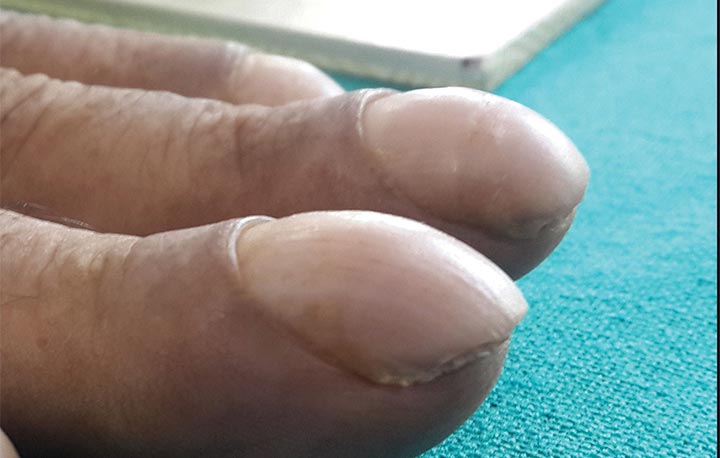Nail clubbing is when your nails appear wider, spongelike or swollen, like an upside-down spoon. Clubbed nails are often a sign of a health condition that needs treatment, such as lung cancer. Treating the underlying condition may help nails return to normal.
Advertisement
Cleveland Clinic is a non-profit academic medical center. Advertising on our site helps support our mission. We do not endorse non-Cleveland Clinic products or services. Policy

Nail clubbing is a change in the appearance and structure of your fingernails or toenails that can occur as a symptom of an underlying health condition. If you have nail clubbing, your nails may:
Advertisement
Cleveland Clinic is a non-profit academic medical center. Advertising on our site helps support our mission. We do not endorse non-Cleveland Clinic products or services. Policy
Nail clubbing can affect a few of your nails or all of them. Often, it starts in your thumb and forefinger (pointer finger) before spreading to other nails.
Nail clubbing often occurs gradually and may be hard to spot at first. In the early stages, you may notice any of the following:
Nail clubbing is most often associated with diseases of the heart and lungs, like lung cancer, lung infections, interstitial lung disease, cystic fibrosis or cardiovascular disease.
Nail clubbing can also happen if you have:
Advertisement
Nail clubbing itself isn’t harmful and usually isn’t painful. Sometimes, nail clubbing occurs in a healthy person without an obvious reason. However, it’s often a sign of a serious health condition that needs medical care, so don’t wait to get it evaluated by a healthcare provider.
Because nail clubbing is usually a sign of an underlying health condition, providers typically direct treatment at the underlying cause. For example, your treatment plan may include:
After treating the cause of nail clubbing, your nails may gradually return to normal. However, nail clubbing isn’t always reversible.
There’s no known way to prevent nail clubbing. But you can prevent some of the conditions that lead to nail clubbing by doing the following:
If you notice nail clubbing or any changes in your nails, see a healthcare provider. Nail clubbing may be a sign of a health condition that needs treatment.
The health and appearance of your nails are a window into your overall health. See a healthcare provider if you notice any nail changes. Getting treatment for the underlying cause of nail clubbing can help you live your healthiest life possible.
Advertisement
Cleveland Clinic’s primary care providers offer lifelong medical care. From sinus infections and high blood pressure to preventive screening, we’re here for you.

Last reviewed on 11/23/2022.
Learn more about the Health Library and our editorial process.